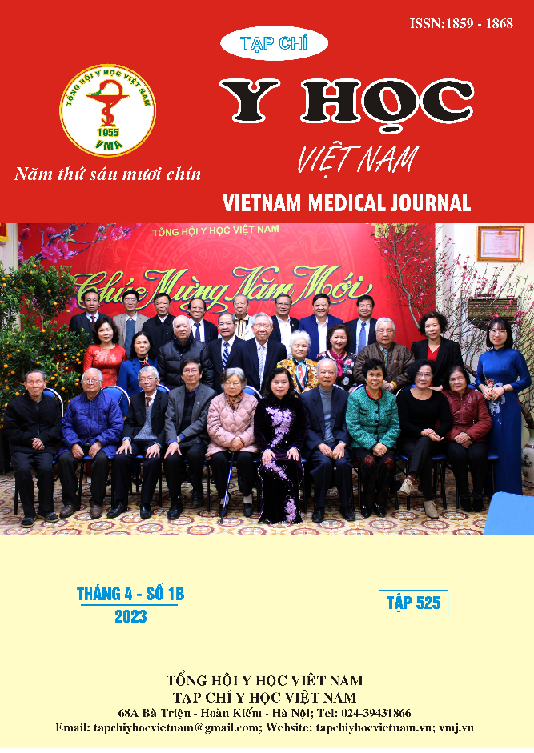EVALUATION OF THE RESULTS OF T-SHAPED CLOSURE WITH GAMBEE INTERRUPTED-SUTURE TECHNIQUES IN LARYNGECTOMY
Main Article Content
Abstract
Background: Laryngeal cancers represent a quarter of head and neck cancers, causing 100.000 deaths worldwide. Most of patients come to the clinic at a late stage, requiring total laryngectomy. Throat closure technique is one of the methods to help reduce complications after total laryngectomy. The T-shape closure method has the advantages of simplicity, stabilization, and few complications. Objective: To examine on general, clinical and paraclinical characteristics of patients with laryngeal cancer undergoing total laryngectomy. To evaluate the results of the T-shape closure with Gambee suture technique in total laryngectomy. Method: Uncontrolled clinical intervention study on LR patients treated at ENT Department of Cho Ray Hospital from 03/2019 to 10/2019. Results: Study on 35 patients with mean age of 62.7 ± 7.8, male rate (97.1%) is higher than female. 77.1% of patients both smoked and drank alcohol. Time from symptom onset to hospital admission for more than 6 months accounted for 60%. Patients came to the clinic because of hoarseness accounting for 85%. Histopathology was moderately differentiated squamous cell carcinoma (68.6%). 25.8% of patients were admitted to the hospital when the cancer had progressed to an advanced stage (IVa). T-shaped closure with GAMBEE suture in total laryngectomy with postoperative complications was pharyngeal fistula (8.6%), fluid collection at surgical site (8.6%), bleeding (5.7%), pneumonia (2.9%), and neck flap infection (2.9%). The average time to start oral feeding after surgery was 9.2 ± 6.3 days. The mean hospital stay after surgery was 12.6 ± 2.6 days. None of the patients had tracheostomy stenosis. After 1 month of surgery, no patient had difficulty swallowing. Conclusion: T-shape closure method with Gambee interrupted-suture technique in laryngectomy is highly effective and has few complications.
Article Details
Keywords
Laryngeal cancer, total laryngectomy, T-shape closure, Gambee interrupted suture technique
References
2. Aswani J, Thandar M, Otiti J, Fagan J (2009), "Early oral feeding following total laryngectomy", The Journal of Laryngology & Otology, 123 (3), pp. 333 - 338.
3. Goepfert Ryan P, Hutcheson Katherine A, Lewin Jan S, Desai Neha G, Zafereo Mark E, Hessel Amy C, Lewis Carol M, Weber Randal S, Gross Neil D (2017), "Complications, hospital length of stay, and readmission after total laryngectomy", Cancer, 123 (10), pp. 1760 - 1767.
4. Govindasamy Gopu, Shanmugam Subbiah (2019), "A review of pharyngeal mucosal closure technique in total laryngectomy", Int. J. Otorhinolaryngol. Head Neck Surg.,5(1), pp.145-148.
5. Hay Ashley, Pitkin Lisa, Gurusamy Kurinchi (2014), "Early versus Delayed Oral Feeding in Patients following Total Laryngectomy", Advances in Otolaryngology, 2014.
6. Herranz Jesús, Sarandeses Adolfo, Fernández Mario Fernández, Barro Carlos Vázquez, Vidal José Martínez, Gavilán Javier (2000), "Complications after total laryngectomy in nonradiated laryngeal and hypopharyngeal carcinomas", Otolaryngology - Head and Neck Surgery, 122 (6), pp. 892 - 898.
7. Hinerman Russell W, Mendenhall William M, Amdur Robert J, Villaret Douglas B, Robbins K Thomas (2002), "Early laryngeal cancer", Current treatment options in oncology, 3(1), pp. 3-9.
8. Martine F, Rinkel Rico NPM, Eerenstein Simone EJ (2017), “The influence of closure technique in total laryngectomy on the development of a pseudo-diverticulum and dysphagia” Eur Arch Otorhinolaryngol, 274 (4), pp. 1967 - 1973.
9. Nguyễn Đinh Bảo Quỳnh (2014), “Khảo sát chức năng nuốt sau mổ cắt thanh quản toàn phần do ung thư tại Bệnh viện Chợ Rẫy”, Luận Văn Thạc sĩ Y học, Trường Đại học Y dược thành phố Hồ Chí Minh.
10. Nguyễn Đình Phúc, Lê Minh Kỳ, Đàm Trọng Nghĩa (2009), "Biến chứng do nạo vét hạch cổ ở bệnh nhân ung thư thanh quản", Y học thực hành, (777), tr. 23 - 28.
11. Nguyễn Mạnh Quốc, Vũ Văn Vũ, Nguyễn Chấn Hùng (2004), "Dịch tễ học và ghi nhận ung thư", Ung bướu học nội khoa, Nhà xuất bản Y học, tr. 15 - 20.
12. Talwar B, Donnelly R, Skelly R, Donaldson M (2016), "Nutritional management in head and neck cancer: United Kingdom National Multidisciplinary Guidelines", The Journal of Laryngology & Otology, 130 (S2), pp. S32 - S40.


